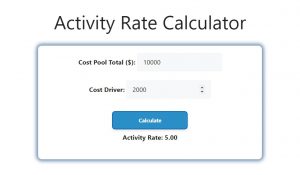About Activity Rate Calculator (Formula)
In today’s competitive business environment, accurately determining costs is essential for effective budgeting and financial management. The Activity Rate Calculator is a powerful tool that helps businesses allocate costs to various activities based on their consumption of resources. By calculating the activity rate, companies can better understand their operational efficiencies and make informed decisions regarding pricing, budgeting, and resource allocation. This article will delve into the formula, usage, and practical examples of the Activity Rate Calculator.
Formula
The formula to calculate the activity rate is:
Activity Rate = Cost Pool Total / Cost Driver
In this formula:
- Cost Pool Total refers to the total costs associated with a specific activity or set of activities.
- Cost Driver is the measure used to allocate costs within the cost pool, such as machine hours, labor hours, or units produced.
How to Use
Using the Activity Rate Calculator is simple and can be broken down into the following steps:
- Determine the Cost Pool Total: Gather all relevant costs associated with the activities you want to analyze.
- Identify the Cost Driver: Choose the appropriate cost driver that best reflects the usage of resources for the activities in question.
- Input Values: Enter the cost pool total and cost driver into the calculator.
- Calculate: Click the “Calculate” button to obtain the activity rate.
- Analyze Results: Review the output to understand the cost per unit of activity, helping you make informed financial decisions.
Example
Let’s consider an example where:
- Cost Pool Total: $10,000 (costs related to machine operations)
- Cost Driver: 2,000 machine hours
To calculate the activity rate:
Activity Rate = Cost Pool Total / Cost Driver
Activity Rate = $10,000 / 2,000
Activity Rate = $5
In this case, the activity rate would be $5 per machine hour.

FAQs
- What is an activity rate?
The activity rate is the cost associated with performing a specific activity, calculated by dividing the total costs by the relevant cost driver. - Why is the activity rate important?
It helps businesses allocate costs more accurately, leading to better pricing strategies and improved budgeting. - What are cost drivers?
Cost drivers are factors that cause changes in the cost of an activity, such as labor hours, machine hours, or units produced. - How do I choose a cost driver?
Select a cost driver that closely relates to the costs being analyzed and accurately reflects resource consumption. - Can the activity rate change over time?
Yes, the activity rate can fluctuate based on changes in costs, production levels, and efficiency improvements. - How can I improve my activity rate?
To enhance your activity rate, focus on reducing costs, improving operational efficiency, or optimizing resource utilization. - Is the activity rate the same as overhead rate?
While related, the activity rate specifically measures costs for particular activities, whereas the overhead rate generally refers to indirect costs spread across all activities. - How often should I calculate my activity rate?
It’s advisable to recalculate your activity rate regularly or whenever significant changes occur in costs or production levels. - Can I use the Activity Rate Calculator for different types of costs?
Yes, you can use it for various cost types, including direct and indirect costs, as long as you have the appropriate cost pool and driver. - What are the benefits of using an Activity Rate Calculator?
It simplifies the cost allocation process, enhances accuracy in financial reporting, and supports strategic decision-making. - What industries can benefit from using an Activity Rate Calculator?
Manufacturing, healthcare, service industries, and any sector with complex cost structures can benefit from this tool. - Can I manually calculate the activity rate?
Yes, you can manually calculate it using the formula, but the calculator provides quicker and more accurate results. - What data do I need to input into the calculator?
You need the total costs associated with the activity (cost pool) and the relevant cost driver. - How can I use the activity rate in pricing strategies?
By understanding the activity rate, you can set prices that cover costs while ensuring profitability. - Is the Activity Rate Calculator suitable for small businesses?
Absolutely! It can help small businesses accurately allocate costs and manage budgets effectively. - What should I do if my activity rate seems too high?
Analyze your cost drivers and cost pool to identify areas for cost reduction or efficiency improvements. - How can I track changes in my activity rate over time?
Keep records of your cost pools and drivers, and regularly update the calculator to monitor changes. - Can this calculator help with project management?
Yes, understanding the activity rate can aid in budgeting for projects and ensuring resources are allocated efficiently. - What is the difference between fixed and variable cost drivers?
Fixed cost drivers remain constant regardless of production levels, while variable cost drivers fluctuate with production changes. - How can I integrate the activity rate into my financial reports?
Include the activity rate in cost analysis sections of your reports to provide insight into operational efficiency.
Conclusion
The Activity Rate Calculator is a valuable resource for businesses seeking to enhance their cost management and decision-making processes. By accurately calculating the activity rate, companies can optimize their costing strategies, allocate resources more effectively, and ultimately improve profitability. Whether you are a small business owner or a financial manager, leveraging this calculator can provide critical insights into your operations and contribute to your overall success.